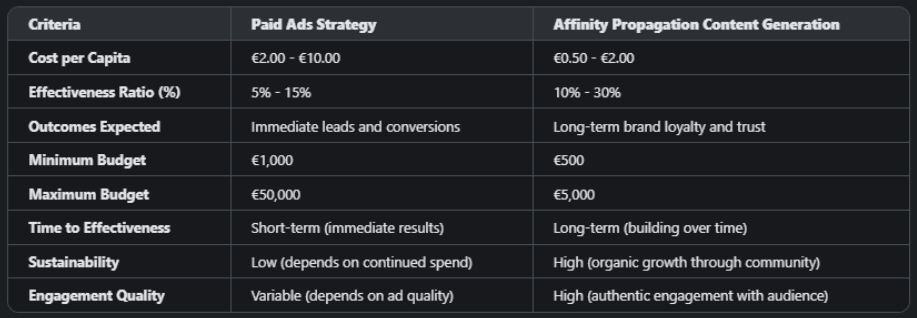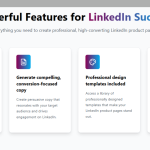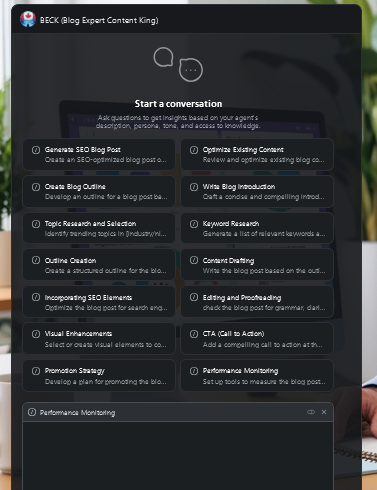
Paid Ads vs. Affinity Propagation: Which Boosts Growth Best?
Affinity Propagation for Lasting Business Impact
In today’s competitive digital landscape, selecting the right marketing strategy is crucial for the success of any business. With numerous options available, two of the most prominent strategies are Paid Advertising and Affinity Propagation Content Generation. This blog post aims to compare these strategies based on various statistical metrics, helping you make an informed decision for your marketing efforts.
Understanding Paid Ads Strategy
What is Paid Advertising?
Paid advertising, often referred to as pay-per-click (PPC) marketing, involves businesses paying for visibility on various platforms. This strategy is designed to drive immediate traffic and conversions by placing ads in front of targeted audiences. Common platforms for paid ads include:
- Google Ads: Display ads on search engine results pages.
- Facebook Ads: Target specific demographics on social media.
- Instagram Ads: Visual ads for engagement on a highly visual platform.
Key Metrics of Paid Ads
To evaluate the effectiveness of a Paid Ads strategy, consider the following key metrics:
- Cost per Capita: Ranges from €2.00 to €10.00, varying based on competition and targeting options.
- Effectiveness Ratio: Typically between 5% and 15%, influenced by ad quality and relevance.
- Immediate Outcomes: Known for quick lead generation and conversions, making it ideal for time-sensitive promotions.
- Budgeting:
- Minimum Budget: €1,000
- Maximum Budget: €50,000
Advantages and Disadvantages of Paid Ads
Advantages
- Immediate Visibility: Quickly place your brand in front of a wide audience.
- Targeted Outreach: Tailor ads to specific demographics for highest impact.
Disadvantages
- High Costs: Expenses can escalate quickly, especially during competitive times.
- Low Sustainability: Once the budget runs out, visibility diminishes.
The Power of Affinity Propagation Content Generation
What is Affinity Propagation?
Affinity Propagation Content Generation focuses on creating meaningful relationships with your audience through valuable content. This strategy prioritizes understanding audience preferences and fostering community engagement, which is vital for long-term success.
Key Metrics of Affinity Propagation
When assessing Affinity Propagation, consider these important metrics:
- Cost per Capita: More affordable, ranging from €0.50 to €2.00.
- Effectiveness Ratio: Higher engagement potential, with expected outcomes between 10% and 30%.
- Long-term Benefits: This approach helps build brand loyalty and trust over time.
- Budgeting:
- Minimum Budget: €500
- Maximum Budget: €5,000
Advantages and Disadvantages of Affinity Propagation
Advantages
- Lower Costs and Higher Sustainability: Offers a more budget-friendly option with potential for ongoing engagement.
- Authentic Engagement: Builds genuine connections with your audience.
Disadvantages
- Slower Results: May take longer to see immediate leads compared to paid strategies.
Comparative Analysis of Both Strategies
Scoring Breakdown
To provide a clear comparison, both strategies were scored based on key criteria on a scale from 0 to 100:
| Criteria | Paid Ads Strategy Score | Affinity Propagation Score |
|---|---|---|
| Cost per Capita | 40 | 80 |
| Effectiveness Ratio (%) | 60 | 90 |
| Expected Outcomes | 70 | 90 |
| Minimum Budget | 60 | 80 |
| Maximum Budget | 40 | 80 |
| Time to Effectiveness | 80 | 50 |
| Sustainability | 40 | 90 |
| Engagement Quality | 50 | 90 |
Total Scores:
- Paid Ads Strategy: 440 / 800 (55%)
- Affinity Propagation: 600 / 800 (75%)
Visual Representation

Conclusion: Which Strategy to Choose?
In summary, the analysis indicates that while Paid Ads can deliver immediate visibility and quick leads, they often come with higher costs and lower sustainability. In contrast, Affinity Propagation Content Generation not only offers lower costs but also better engagement quality and long-term sustainability.
Recommendations for Businesses
- Consider Goals and Budget: Evaluate your company’s specific needs to choose the right strategy.
- Combine Both Strategies: Embrace a mix of paid advertising and organic content generation for maximum effectiveness.
The long-term benefits of affinity propagation in building community engagement and trust cannot be overlooked. This strategy paves the way for sustained growth and deeper customer connections, essential in today’s market.
Decide today, win tomorrow!
Call to Action
We encourage you to evaluate your current marketing strategies. If you’re looking for guidance, download our comprehensive checklist for choosing the right marketing strategy today!
By understanding the strengths and weaknesses of each approach, you can position your business for success in an ever-evolving digital landscape.
BECK LLM – Content Accelerator
Generate SEO Blog Post. Optimize Existing Content. Create Blog Outline. Write Blog Introduction. Topic Research and Selection.
Advanced blog post templates and outlines. keyword research tool. Content Drafting. Incorporating SEO Elements. Editing and Proofreading. CTA (Call to Action).
Long-Term Benefits of Content Marketing | Cost-Effective Advertising Strategies | Understanding PPC (Pay-Per-Click) Effectiveness | The Role of Audience Targeting in Digital Marketing | SEO vs. Paid Ads: Which is Right for Your Business? | Creating a Balanced Marketing Strategy
GET a second opinion











